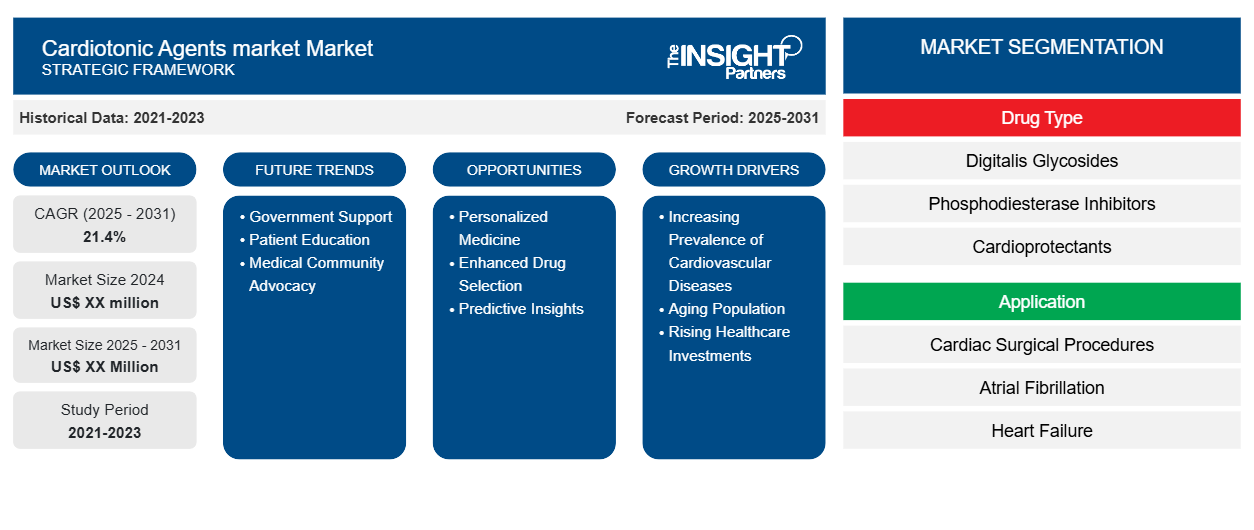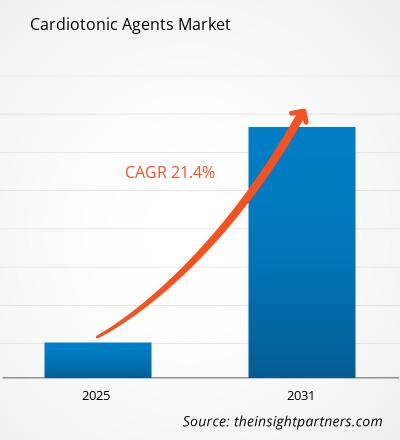The Cardiotonic Agents Market is expected to register a CAGR of 21.4% from 2025 to 2031, with a market size expanding from US$ XX million in 2024 to US$ XX Million by 2031.
The report is segmented by OTC Consumer Healthcare Market By Drug Type (Digitalis Glycosides, Phosphodiesterase Inhibitors, Cardioprotectants, Sympathomimetic Agents, and Others); Application (Cardiac Surgical Procedures, Atrial Fibrillation, Heart Failure, Pulmonary Hypertension, and Others); Route of Administration (Oral and Parenteral); Dosage Form (Tablet, Solutions, and Others); Distribution Channel (Hospital Pharmacies, Retail Pharmacies, and Online Pharmacies) , and Geography (North America, Europe, Asia Pacific, Middle East & Africa, and South & Central America). The global analysis is further broken-down at regional level and major countries. The Report Offers the Value in USD for the above analysis and segments.
Purpose of the Report
The report Cardiotonic Agents Market by The Insight Partners aims to describe the present landscape and future growth, top driving factors, challenges, and opportunities. This will provide insights to various business stakeholders, such as:
- Technology Providers/Manufacturers: To understand the evolving market dynamics and know the potential growth opportunities, enabling them to make informed strategic decisions.
- Investors: To conduct a comprehensive trend analysis regarding the market growth rate, market financial projections, and opportunities that exist across the value chain.
- Regulatory bodies: To regulate policies and police activities in the market with the aim of minimizing abuse, preserving investor trust and confidence, and upholding the integrity and stability of the market.
Cardiotonic Agents Market Segmentation
Drug Type
- Digitalis Glycosides
- Phosphodiesterase Inhibitors
- Cardioprotectants
- Sympathomimetic Agents
- Others
Application
- Cardiac Surgical Procedures
- Atrial Fibrillation
- Heart Failure
- Pulmonary Hypertension
- Others
Route of Administration
- Oral and Parenteral
Dosage Form
- Tablet
- Solutions
- Others
Distribution Channel
- Hospital Pharmacies
- Retail Pharmacies
- Online Pharmacies
You will get customization on any report - free of charge - including parts of this report, or country-level analysis, Excel Data pack, as well as avail great offers and discounts for start-ups & universities
Cardiotonic Agents market Market: Strategic Insights

-
Get Top Key Market Trends of this report.This FREE sample will include data analysis, ranging from market trends to estimates and forecasts.
Cardiotonic Agents Market Growth Drivers
- Increasing Prevalence of Cardiovascular Diseases:The prevalence of cardiovascular diseases (CVDs) is rising worldwide, and it is predicted that more than 6.5 million North Americans will have heart failure by 2030. The need for efficient treatment options, such as cardiotonic medicines, is fueled by this expanding patient population.
- Aging Population: The necessity for cardiotonic therapy is further increased by the fact that an older population is more prone to heart-related illnesses. Age-related cardiovascular problems are more common as life expectancy rises, which drives market expansion.Such a factor has assisted the overall market growth in the recent past and is expected to continue a similar trend during the forecast period.
- Rising Healthcare Investments:The development and accessibility of sophisticated cardiotonic therapies are facilitated by higher healthcare spending in areas such as North America. Improved access to these drugs is made possible by improved healthcare infrastructure, which fuels market expansion.Such a factor has assisted the overall market growth in the recent past and is expected to continue a similar trend during the forecast period.
Cardiotonic Agents Market Future Trends
- Government Support:The market for cardiotonic agents is also supported by a number of government programs that use money and public health campaigns to improve cardiovascular health. These efforts frequently include of funding for studies and campaigns raising awareness of heart health.
- Patient Education:Demand is being driven by patients' and healthcare professionals' growing awareness of cardiovascular illnesses and diseases and the advantages of cardiotonic medications. Campaigns for education assist in educating stakeholders about the value of various medicines in the management of cardiac diseases.
- Medical Community Advocacy:Cardiotonic drugs are becoming more widely accepted and used in clinical practice as a result of the medical community's increased focus on their advantages in treating heart failure and other cardiovascular disorders. Cardiotonic medications are in greater demand as part of post-COVID care regimens because of the COVID-19 pandemic's increased reporting of cardiovascular problems among recovered patients. As healthcare systems adjust to the pandemic's long-term consequences on heart health, this tendency is anticipated to continue.
Cardiotonic Agents Market Opportunities
- Personalized Medicine:Medical practitioners can find particular genetic markers linked to heart failure and other cardiovascular disorders through genetic testing. This makes it possible to create individualized treatment programs that maximize the use of cardiotonic medicines, increasing their effectiveness and lowering their side effects. Because personalized treatments are more likely to provide favorable results, there is a greater need for cardiotonic medicines that are suited to the demands of specific patients.
- Enhanced Drug Selection: Clinicians can choose the best cardiotonic medicines by knowing a patient's hereditary susceptibility to specific cardiovascular diseases. Genetic testing is a useful tool in directing therapeutic decisions since, for instance, people with particular genetic variants may respond better to various drugs.
- Predictive Insights:A patient's risk of heart failure or poor response to conventional therapy can be inferred from genetic testing. Early intervention with cardiotonic medicines is made possible by this predictive skill, which may enhance patient outcomes and quality of life.Such a factor has assisted the overall market growth in the recent past and is expected to continue a similar trend during the forecast period.
Cardiotonic Agents market Market Regional Insights
The regional trends and factors influencing the Cardiotonic Agents market Market throughout the forecast period have been thoroughly explained by the analysts at The Insight Partners. This section also discusses Cardiotonic Agents market Market segments and geography across North America, Europe, Asia Pacific, Middle East and Africa, and South and Central America.
Cardiotonic Agents market Market Report Scope
| Report Attribute | Details |
|---|---|
| Market size in 2024 | US$ XX million |
| Market Size by 2031 | US$ XX Million |
| Global CAGR (2025 - 2031) | 21.4% |
| Historical Data | 2021-2023 |
| Forecast period | 2025-2031 |
| Segments Covered |
By Drug Type
|
| Regions and Countries Covered |
North America
|
| Market leaders and key company profiles |
|
Cardiotonic Agents market Market Players Density: Understanding Its Impact on Business Dynamics
The Cardiotonic Agents market Market is growing rapidly, driven by increasing end-user demand due to factors such as evolving consumer preferences, technological advancements, and greater awareness of the product's benefits. As demand rises, businesses are expanding their offerings, innovating to meet consumer needs, and capitalizing on emerging trends, which further fuels market growth.

- Get the Cardiotonic Agents market Market top key players overview
Key Selling Points
- Comprehensive Coverage: The report comprehensively covers the analysis of products, services, types, and end users of the Cardiotonic Agents Market, providing a holistic landscape.
- Expert Analysis: The report is compiled based on the in-depth understanding of industry experts and analysts.
- Up-to-date Information: The report assures business relevance due to its coverage of recent information and data trends.
- Customization Options: This report can be customized to cater to specific client requirements and suit the business strategies aptly.
The research report on the Cardiotonic Agents Market can, therefore, help spearhead the trail of decoding and understanding the industry scenario and growth prospects. Although there can be a few valid concerns, the overall benefits of this report tend to outweigh the disadvantages.
Frequently Asked Questions
Which country held the second largest share in Europe in 2023?
Which region is expected to register highest growth during the forecast period?
Which region held the largest share in 2023?
What is the expected CAGR of the Cardiotonic Agents Market?
What is the opportunity impacting the cardiotonic agents market?
What is the driving factor impacting the cardiotonic agents Market?
- Historical Analysis (2 Years), Base Year, Forecast (7 Years) with CAGR
- PEST and SWOT Analysis
- Market Size Value / Volume - Global, Regional, Country
- Industry and Competitive Landscape
- Excel Dataset
Recent Reports
Testimonials
Reason to Buy
- Informed Decision-Making
- Understanding Market Dynamics
- Competitive Analysis
- Identifying Emerging Markets
- Customer Insights
- Market Forecasts
- Risk Mitigation
- Boosting Operational Efficiency
- Strategic Planning
- Investment Justification
- Tracking Industry Innovations
- Aligning with Regulatory Trends





















 Get Free Sample For
Get Free Sample For